27
Ricky (Richard) Hawkins as an altar boy1954-1958
St. John the Baptist Church (1950), Fort McMurray, Alberta, Canada
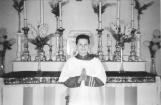 Credits:
Credits:School Reunion
Fort McMurray Historical Society
28
Grades 6, 7, and 8 at St. John's Roman Catholic School1944
St. John's Roman Catholic School, Fort McMurray, Alberta, Canada
 Credits:
Credits:Doris Somers
Fort McMurray Historical Society
29
Merle Rudiak: Student and TeacherMerle Golosky, along with her five brothers and one sister, attended St. John's School. Merle and her brother Grant went to the public school but attended St. John's for Catechism classes (i.e. religious education classes). When Merle was entering grade six, her mother told her she was being switched into the Catholic school. She remembers that she cried she was so upset because now she would be playing baseball against her friends rather than with them. When she got to the school, her first teacher was Sister Agnes Sutherland, who she remembers as a 'good sport.' At that time Sister Boulet was the principal and called herself 'The Old Bird.'
Merle found the nuns liberal in their thinking. She said as a girl that she did not think marriage should be a life-long commitment, reasoning that at eighteen a person cannot be expected to know whether they could live with someone until death. Rather, Merle suggested, marriage should be a contract automatically up for renewal or cancellation after three years. If renewed, it would only ever last five years at a time. While Sister Lapointe never endorsed this line of thinking, she was willing to discuss it and never said that Merle was wrong.
Merle had originally wanted to quit school in grade ten and join the Air Force, but Sister Lapointe talked her into becoming a teacher. She went to the University of Alberta, where she was shocked by the class sizes. In Fort McMurray, classes might only have a dozen students. In Edmonton, the classes were much bigger. Merle returned to Fort McMurray in 1958 to teach at St. John's, where Sister Lapointe was now her boss. During her first year she taught grades five and six, totalling 35 students combined. 19 of them were boys. She says of the boys, "When they found out I could build a good airplane, they said it was okay for me to teach them." While she only taught at St. John's for one year this time, she returned to Fort McMurray and St. John's again in 1965. She and Jeanne Golosky shared a teacherage and "lived a lot on noodle soup." For three years she taught grade one, during which time she met and wed Peter Rudiak, taking time off for her family.
30
Jim and Jane Lawrence at St. John's School initiationNovember 1964
St. John's Roman Catholic School, Fort McMurray, Alberta, Canada
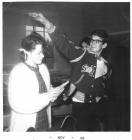 Credits:
Credits:Mary Jane Peden
Fort McMurray Historical Society
31
The Mystery StudentFrank MacDonagh and Frank Peters reminisce about a student who they refuse to name. He was a renowned lock pick, though he was embarrassed when he could not get into his own locker, having forgotten the lock's combination. This young man had "a heart of gold," even though it was set on the wrong things. The former teachers remember when St. John's needed a Christmas tree and the student said not to worry because they would have one tomorrow. The next morning, a 15-foot tree had been delivered to the school. Amid jubilation at the unexpected gift, the Principal received a phone call. The call was from a local woman who claimed to have seen two boys running away with a tree from her back yard. "Still, St. John's had a beautiful Christmas tree that year," they recall.
Frank MacDonagh also recalls a less charitable misdemeanour. For a $1.00 bet, the mystery student set the school on fire. He went into the attic, stacked paper behind the door, and lit a fire. As he was leaving the building, he ran into Peter Hobbs, the vice principal. Caught in a conversation, he sat on the steps and spoke calmly for an hour to the vice principal while upstairs the fire was getting started. In the end, only part of the school was damaged.
32
Middle school students on steps at St. John's Roman Catholic School1955
St. John's Roman Catholic School, Fort McMurray, Alberta, Canada
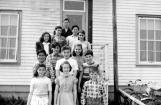 Credits:
Credits:School Reunion
Fort McMurray Historical Society
33
Interesting Figures at St. John's SchoolJeanne Durieux of Tree House, Alberta, (later Jeanne Golosky) came to Fort McMurray in September 1956 as a teacher at St. John's School. When she arrived, school had already started and her housing, a teacherage for single women like herself, was still in construction. Golosky stayed with a married couple until the construction was finished in October. The teacherage's three rooms consisted of a bedroom, a kitchen, and a living room, with an outhouse out back.
Golosky recalls the teachers of her first year. Nuala Seguin taught grade one in the Church basement and Giselle Golosky (nee Lapointe) taught grade two and some of the grade three students in the school attic. Jeanne Golosky herself taught a combined grade three and four class. Sister Pouliot taught grades five and six, as well as a few grade four students. Walter Walcer taught grades seven and nine, while Sister Lapointe taught grades ten through twelve.
Golosky taught for three years. During her second year of teaching she met and married Bert Golosky, and during her third and final year at the school she gave birth to the first of six daughters. She returned to education in 1968, teaching at J. A. Turcotte Elementary. She remembers that children wanted to learn.
Frank Peters left Ganway, Ireland, in 1965, headed to Fort Chipewyan to teach. He came to Fort McMurray in 1967 as Vice Principal of St. John's, when the school was teaching grades one through eleven. 348 students were registered in September of 1967. He was impressed with Sister Sutherland, but worried about working with Sister Gagnon, whom he thought of as saint-like. After getting to know her, however, he found that she was as human as anyone else. In 1968, Peters was appointed Principal of J. A. Turcotte Elementary, during the school's first year. Later he went to teach at the University of Alberta and at Keyano College in Fort McMurray.
Frank McDonagh came from Ireland to teach in Saskatchewan. He moved to Fort McMurray in 1970 and taught at St. John's for the following decade.
Romeo and Tessie Gonzalez were the first Filipino couple to marry in Fort McMurray. They were both teachers at St. John's.
34
Grade 8 students playing baseball1950-1959
Fort McMurray, Alberta, Canada
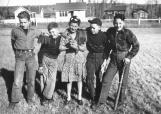 Credits:
Credits:School Reunion
Fort McMurray Historical Society
35
Teenage girls on bus to play volleyball in Edmonton1965
Edmonton, Alberta, Canada
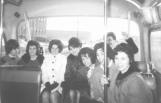 Credits:
Credits:Mary Jane Peden
Fort McMurray Historical Society
36
The Impact of St. John's Roman Catholic SchoolDespite a rocky start and on-going staff and resource shortages, St. John's Roman Catholic School provided a key element to the community's makeup: education. During the St. John's Separate School Board's first years, splitting the student population into smaller groups seemed financially unwise and threatened to bankrupt both the public and the separate schools. The dedication of regional bishops and the work of local citizens allowed the school to remain open and adequately funded. Fort McMurray's population expanded after the oil sands companies began to develop the area. When this happened, the presence of multiple schools and school boards became a blessing. As it was, the schools could hardly house the influx of students. The rapid construction of new schools in the 60s, 70s, and 80s indicates that dividing the population was no longer an issue.
The Catholic School Board also provided a different education than the public system. It offered grades eleven and twelve before the public school did. St. John's Catholic School also accepted transfers when the public board could not afford to run the upper grades. At least a few citizens switched into the Catholic system because they believed that St. John's School's quality of education was superior to the public system's. The public system, of course, was unable to call upon the Grey Nuns for assistance. These women taught in St. John's and the other Catholic schools virtually for free, and they worked hard both in and out of the classroom. These factors all contributed to providing a different--and some would argue better--education than the public system.
As far as the Mission was concerned, the primary reason for establishing the Catholic school board was to teach catechism and Catholic values. Unable to insist on Catholic education in the public school system, the clergy that pioneered this Board and others in northern Canada wanted to fulfill Article 26 of the Universal Declaration of Human Rights. This article guarantees parents' right to determine their child's education. Since its creation, the Catholic board has maintained the value of religious teaching and provided it to those who wished to be a member of their schools.
For more information about the Grey Nuns, read "Northerners Say: 'Thanks, Sisters,'" by Agnus Sutherland s.g.m, and published by Les Oeuvres de Mère d'Youville in 1996. See also "The Bishop Who Cared: A Legacy of Leadership," written and published by Agnus Sutherland s.g.m. in 1995. For more information about the Catholic Schools of Fort McMurray, see "Fort McMurray Catholic Schools Celebrate Their 50th Anniversary 1936-1986," written by Joan Jarvis and published by The Fort McMurray Catholic Board of Education in 1986, and "'Those Were The Days': Fort McMurray All School Reunion August 1, 2, 3, 1981," compiled by Mary-Jane Peden in 1981.
37
Girl at First Communion1950-1969
Fort McMurray, Alberta, Canada
 Credits:
Credits:School Reunion
Fort McMurray Historical Society